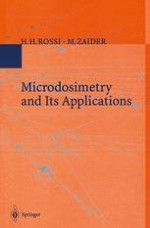1996 | OriginalPaper | Buchkapitel
Other Applications
verfasst von : Harald H. Rossi, Dr. Marco Zaider
Erschienen in: Microdosimetry and Its Applications
Verlag: Springer Berlin Heidelberg
Enthalten in: Professional Book Archive
Aktivieren Sie unsere intelligente Suche, um passende Fachinhalte oder Patente zu finden.
Wählen Sie Textabschnitte aus um mit Künstlicher Intelligenz passenden Patente zu finden. powered by
Markieren Sie Textabschnitte, um KI-gestützt weitere passende Inhalte zu finden. powered by
In the application of microdosimetry to radiation biology a distinction needs to be made between direct and indirect effects (see section VI.1.5.2). In the case of direct effect of radiation the spatial pattern of altered target molecules is expected to coincide with that of the initial energy deposits44. In contrast, indirect action depends not only on the initial microdosimetric distribution (as represented, for example, by the radical species generated by radiation in the medium surrounding the target) but also on the probability that radicals that survive interactions among themselves diffuse and collide with the target molecule. Clearly the pattern of molecules modified indirectly is time dependent and not identical to that of the initial track. The qualitative features of these changes are illustrated in Fig.VII.1: the four panels (Turner et al, 1983) correspond to “snapshots” of the track of a 4 keV electron taken at times ranging from 1 psec to 0.1 μsec following passage through liquid water. During this time interval more than half of the initial radical species have reacted among themselves or have been converted to unreactive molecules; and one also notes the increasingly diffuse appearance of the track — in effect a decrease in the energy density of the track. Target molecules damaged indirectly by the track will have a spatial distribution that mimics the appearance of the track at the time of the reaction. This has important biological consequences: For instance, double strand breaks (dsb) in DNA result from the pairwise combination of single strand breaks (ssb) whenever they are within approximately 10 base pairs45. The relative distance between ssb-s produced in indirect action depends in turn on the pattern of hydroxyl radicals, OH, assumed to be the main species attacking the DNA molecule. In a medium containing scavengers of OH radicals — as is usually the case intracellularly — only OH radicals within several nanometers of the DNA may yield ssb-s; the others would have been scavenged earlier. Because of this the time available for diffusion is only several nanoseconds and, paradoxically, in the presence of a scavenger the probability of induced ssb-s to yield dsb-s is larger (compare second and fourth panels in Fig.VII.1). It has been hypothesized also that the spatial proximity of damaged targets may affect their chance of being enzymatically repaired in the cell.
